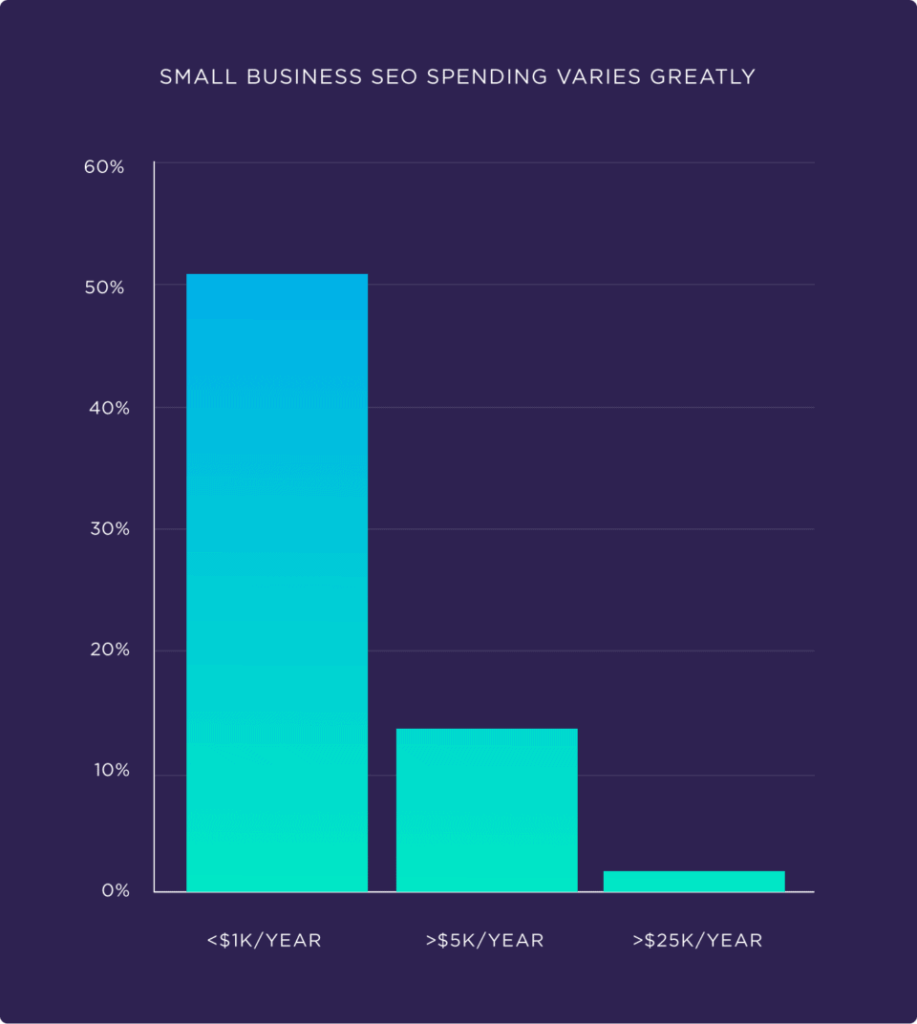SEO has long been the cornerstone of successful online marketing strategies — but as search engine algorithms and SEO best practices continue to evolve, it has also become a breeding ground for outdated information, half-truths, and misguided tactics.
Some of the biggest SEO myths still hanging around in 2024 can potentially cost you a lot of time, effort, and resources.
So stick around and we’ll chat about everything from local SEO to the impact of AI, and set the record straight so you can create a more effective and sustainable SEO strategy this year.
Why Do SEO Myths Exist?
SEO myths persist for a variety of reasons, including the fact that Google algorithms are continuously being changed and updated. This results in SEO techniques that are no longer effective (even if they were effective in the past) and people interpreting that as “SEO doesn’t work.”
In addition, SEO is a complex process that requires considering many ranking factors and techniques, making it easy for misinformation to spread.
As Bill Slawski, Director of SEO Research at Go Fish Digital, puts it, “There is a lot of misinformation in the world, and some SEOs are much more interested in writing popular clickbait rather than something that may be more accurate.” (via Search Engine Journal).
Finally, the internet is full of unverified claims and quick-fix solutions when it comes to SEO.
Add that to a lack of clear official guidelines from search engines (and no exact details on how their ranking algorithms work) and it’s no surprise that SEO myths are everywhere.
Here’s a breakdown of 10 of the most common SEO myths and why you shouldn’t believe them.
Myth # 1: Local SEO is Not Worth It
Before you reject local SEO for your business, think about this: Local SEO is not just for brick-and-mortar businesses that depend on walk-in clients.
Even if you’re a completely digital business that isn’t location-specific, you can still benefit (and greatly!) from focusing on local SEO. Simply put, local SEO it’s yet another essential strategy that helps you identify and reach your ideal client.
Local SEO, or local search engine optimization, is the process of optimizing your online presence to attract more local customers to your website or physical location. Bluehost defines local SEO as “the process of optimizing your site to achieve better rankings for searches focused on a specific location.”
Sure, people are more likely to search for brick-and-mortar businesses like “best vegetarian restaurant in NYC” than they are to search for “web designers in NYC” — but if you happen to live in NYC and run a web designing firm, why shouldn’t you take advantage of one more opportunity to enhance your visibility on search engine results pages?
Local SEO uses a variety of techniques – including website content optimization, obtaining local citations, making sure your business can be located on Google Maps, and creating locally-focused Google Business Profile listings.
These strategies can help improve a website’s ranking on Google, making it easier for potential customers to find a business — something especially important for small companies.
If there’s any doubt that local SEO is important, think about this: A study conducted by the mighty Google itself found that 30% of Google mobile searches are related to location and 72% of consumers look up the location of a business in Google Maps.
Clearly, optimizing for local search can have a significant impact on a business’ bottom line.
Keep in mind that claiming and optimizing a Google Business Profile listing allows your company to appear in local search results, even if you don’t have a physical office. If you can add to that local reviews and testimonials from satisfied clients in the area, it will help build credibility and trust among potential clients.
Myth # 2: New Content is Required to Rank Higher
Content plays an important part in Google rankings, but this doesn’t mean you need to be writing new content constantly to rank better. What you need is fresh content — which is not necessarily the same thing.
In 2011, Google announced that fresh content would, from then on, be used to determine ranking. This is because information is always changing.
So, according to Google, if “you’re researching the best SLR cameras, or you’re in the market for a new car and want Subaru Impreza reviews, you probably want the most up-to-date information” and not something published five years ago.
A blog post you wrote in 2019 about the best SEO tools on the market is not going to rank so well today, simply because Google will consider the information too old. But go back to it, update it with new tools, and make it fresh for 2024 and surprise!
Google might just love you again.
Myth # 3: Low-volume Search Terms Are a Waste of Time and Money
There are actually many benefits to targeting long-tail keywords and niche markets, and low-volume search terms often return surprisingly high conversion rates.
Long-tail keywords are a good example of financially-smart SEO choices. They are low-volume search terms that aren’t as popular but have the benefit of having less competition than more generic, high-volume keywords.
By focusing on these long-tail keywords, businesses can target niche markets and specific audience segments that are more likely to convert.
For example, that small web design firm we mentioned before might struggle to compete with larger businesses for high-volume keywords like “website design” but choosing a more specific keyword like “website design for dentists” can help capture a niche audience and lead to higher conversion rates.
Perhaps surprising to many is the fact that “70% of all searches performed online consist of long-tail keywords” (via Search Engine Journal). This means that only 30% of businesses bother with the more popular search terms — likely because they know the chance to rank with them is just much lower.
Myth # 4: Google Will Be Replaced by AI
The advent of ChatGPT and other AI platforms might feel new to us, but the truth is that artificial intelligence has been shaping the search experience for a long time.
For example, AI is how Google is able to provide voice search and image search, and AI-driven chatbots have been around for years (RIP SmarterChild).
But what happens when people start asking ChatGPT questions instead of going to Google? Will this impact the value of SEO? In December 2022, The Daily Mail published an article that started with these ominous words: “Gmail creator predicts ‘total disruption’ for Google as new chatbot ChatGPT challenges tech giant’s monopoly on internet searches.”
By February 2023, however, Google had already announced its own AI language model called Bard — no doubt specifically meant to address the potential loss of search traffic to the very popular ChatGPT.
Other search engines are also taking action to avoid losing traffic to AI. According to Digital Trends, Microsoft has integrated ChatGPT into its Bing search engine and the Opera browser is planning to do the same to prevent traffic loss.
Do we know what the future holds for search and SEO now that AI is so widely available?
At the moment, not even the experts can tell us where things are going, but we can be sure Google will find a way to restructure and rebuild to ensure the value of SEO endures. Google made $162.45 billion from search ads in 2022, according to Oberlo. This innovative internet giant will find a way to remain at the top.
Myth # 5: SEO Only Matters For Large Companies
Think only large companies with a massive budget should worry about SEO?
Well, think again.
With the right SEO strategy, even small businesses can make their presence known online and (somewhat) compete with bigger companies in the digital space.
This myth probably comes from another myth — that it’s impossible to beat competitors with bigger SEO budgets than you, so why even bother?
While it’s true that larger budgets can provide more comprehensive SEO strategies, even small investments in SEO can lead to noticeable improvements in online visibility and search rankings. In fact, even a shoestring budget will pay for effective SEO tactics such as keyword research, on-page optimization, and content creation — all great tactics to improve a business’ online presence.
According to a new study by Backlinko, the average small business spends $497 per month on SEO services, with 36% of small businesses spending less than $500 per year on SEO. Done well, this could be enough to improve search rankings and increase organic traffic:

Myth # 6: SEO is a One-Time Thing
Sorry to disappoint you, but SEO is not a “set it and forget it” kind of thing. Sure, much of the hard work is done at the beginning, when you’re optimizing a website so it shows up on search engine results pages.
But, as ThunderTech puts it, SEO is an ongoing process, not a static thing: “No longer is SEO merely keywords and links; rather, sites that cater to users are rewarded. Users’ needs are constantly changing, and your SEO efforts should evolve right along with your audience.”
Google’s dynamic algorithms are one of the reasons SEO is always evolving — as a minimum, you should be updating your SEO every time Google rolls out new algorithms to keep your website optimized and ranking well.
Myth # 7: High Keyword Density is Essential
Keyword stuffing has been dead for many years, but the myth that they’re an important ranking factor seems to persist. In fact, according to a study conducted by Moz, keyword stuffing actually leads to a loss in rankings — the opposite of what it once did.
This is because keyword density can actually harm the readability and quality of your content. According to Search Metrics, “From the point of view of search engines, a high keyword density is a good indicator of search engine spam. If a keyword appears too often in a website, search engines will downgrade the website and it will then appear lower down in search results.”
SEO agency Stan Ventures adds that “Although there is no definite percent score for ideal keyword density, to rank higher in Google listings, a good practice is to stick to a 2% keyword density.” Anything over that will likely be flagged by Google as keyword stuffing and considered spammy.
Myth # 8: Social Media Has No Impact on SEO
Not only has this myth long been debunked, but “social signals” actually play a crucial role in enhancing search engine optimization.
Technically speaking, social signals are not an official Google ranking factor, but experts have found that social signals such as likes, shares, comments, and especially engagement are positively correlated with improved rankings.
This is confirmed by a number of studies, including one by Searchmetrics that shows there’s a strong correlation between social signals and higher search engine rankings. This is because Google rewards content that resonates well with users, and social media engagement is a great indicator of that.
Another study by Hootsuite found that articles with lots of social shares received an average 22% boost in search engines.
As renowned digital marketer Neil Patel puts it, “Nowadays, people don’t just go to Google and Bing to look stuff up; they also use social media channels to find what they’re looking for.” And social media is where a lot of brand awareness and engagement take place.
Myth # 9: LSI Keywords Are Not a Ranking Signal
LSI (Latent Semantic Indexing) keywords are basically terms and related phrases that are closely tied to your target keyword and help search engines understand the context of your content.
Despite what some people may believe, LSI keywords might play a vital role in improving content ranking — but only when used in a very specific way.
Neil Patel points out that LSI keywords can both “provide relevance to your content without keyword overuse” and “offer more ranking opportunities as, by using LSI keywords, you can rank for related terms instead of just your keywords.”
However, when we looked into LSI keywords and their impact on SEO, we found that “it’s not a valid keyword research technique.” This is because Google does not use latent semantic indexing and considers it an outdated technique.
Does that mean you should avoid LSI keywords?
Well, you shouldn’t if they are naturally sounding keywords related to the topic you’re already writing about.
For example, an article on “weight loss tips” could probably benefit from related keywords such as healthy eating habits, calorie intake, diet plans, or workout routines. But pushing these keywords into an article where they don’t naturally fit will do more harm than good.
Myth # 10: SEO is Dead
At this point in time, we hope you don’t truly believe this myth, but just in case, let us reassure you — SEO is definitely NOT dead.
With Google now processing over 40,000 search queries every second on average (that’s over 3.5 billion searches per day), search engine optimization remains a crucial aspect of any online marketing strategy.
In a world where you are competing with millions of other sites for good ranking, SEO is still the one thing that can make it easier for users to find you amid the competition. In fact, a study by BrightEdge shows that organic search is responsible for 53% of all site traffic.
As quoted in The Thaiger, “SEO is thriving, and it isn’t going anywhere soon. It has become a billion-dollar industry, and it’s only getting bigger every year.”
A well-optimized website will continue to ensure that users can easily find relevant content, which in turn can improve your conversion rates.
Hope you had fun debunking some of the most stubborn SEO myths that just won’t quit in 2024. In the end, always remember that the engine landscape will continue to change, and learning to separate truth from myth will go a long way to improving your website’s visibility and achieving long-term success.
Happy optimizing, friends!





